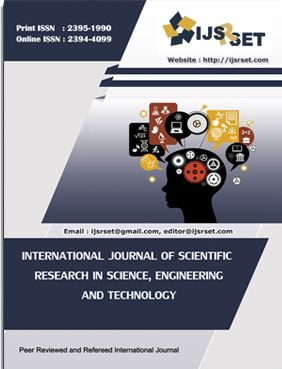Silent Signals: Using EEG and AI to Detect Hidden Mental Health Patterns
DOI:
https://doi.org/10.32628/IJSRSET2512517Keywords:
mental disorders, generic biomarkers, logistic regression, decision trees, random forests, k-nearest neighbors' algorithmAbstract
The insufficient early objective diagnostic tools often result in underdiagnosing of mental disorders. The topic of the work is new: EEG waves are generic biomarkers that help to determine the early signs of mental disease regardless of its type. Two sets of features were elucidated based on the descriptive characteristics of well-known components of ERP (P300 and N200), which were recorded in auditory oddball experiments. These characteristics were tested on two datasets: one included the traumatic brain injury (TBI) patients, and the other (BSNIP) included numerous types of psychiatric illnesses. The five machine learning methods (logistic regression, SVM, decision trees, random forests, and KNN) were applied to test how useful the features formed were in predicting the results. Oversampling processes were used since the data was not evenly distributed, and this makes the review accurate and fair. Results were also promising. In particular, Random Forest and KNN demonstrated high performance. Means of ERP amplitudes were particularly useful at indicating the mental health, yielding a more pure and less variable signal. These results indicate that features derived in EEG may be used as a foundation of cost-effective and affordable general health screening tools that would allow prompt and wide access to care and early diagnosis.
📊 Article Downloads
References
Ahani, A., Wahbeh, H., Nezamfar, H., Miller, M., Erdogmus, D., & Oken, B. (2014). Quantitative change of EEG and respiration signals during mindfulness meditation. Journal of Neuroengineering and Rehabilitation, 11(1), 1–11. DOI: https://doi.org/10.1186/1743-0003-11-87
Ay, B., Yildirim, O., Talo, M., Baloglu, U. B., Aydin, G., Puthankattil, S. D., & Acharya, U. R. (2019). Automated depression detection using deep representation and sequence learning with EEG signals. Journal of Medical Systems, 43, 1–12. DOI: https://doi.org/10.1007/s10916-019-1345-y
Barcelo, F. (2004). Detection of change: Event-related potential and fMRI findings. Kluwer Academic Publishers. DOI: https://doi.org/10.1016/j.clinph.2004.02.002
Bostanov, V., Ohlrogge, L., Britz, R., Hautzinger, M., & Kotchoubey, B. (2018). Measuring mindfulness: A psychophysiological approach. Frontiers in Human Neuroscience, 12, 249. DOI: https://doi.org/10.3389/fnhum.2018.00249
Broadway, J., Rieger, R., Campbell, R., Quinn, D., Mayer, A., Yeo, R., ... & Cavanagh, J. (2020). Joint analysis of frontal theta synchrony and white matter following mild traumatic brain injury.
Cavanagh, J. F., & Quinn, D. (2021). EEG: Three-stim auditory oddball and rest in acute and chronic TBI.
Cavanagh, J. F., Wilson, J. K., Rieger, R. E., Gill, D., Broadway, J. M., Remer, J. H. S., ... & Quinn, D. K. (2019). ERPs predict symptomatic distress and recovery in sub-acute mild traumatic brain injury. Neuropsychologia, 132, 107125. DOI: https://doi.org/10.1016/j.neuropsychologia.2019.107125
Cayoun, B. A. (2011). Mindfulness-integrated CBT: Principles and practice. John Wiley & Sons. DOI: https://doi.org/10.1002/9781119993162
Chmielewski, M., Clark, L. A., Bagby, R. M., & Watson, D. (2015). Method matters: Understanding diagnostic reliability in DSM-IV and DSM-5. Journal of Abnormal Psychology, 124(3), 764. DOI: https://doi.org/10.1037/abn0000069
Cortes, C., & Vapnik, V. (1995). Support-vector networks. Machine Learning, 20(3), 273–297. DOI: https://doi.org/10.1023/A:1022627411411
Hu, Q., Yu, D., & Xie, Z. (2008). Neighborhood classifiers. Expert Systems with Applications, 34(2), 866–876. DOI: https://doi.org/10.1016/j.eswa.2006.10.043
Costello, E. J. (2016). Early detection and prevention of mental health problems. Journal of Clinical Child & Adolescent Psychology, 45(6), 710–717. DOI: https://doi.org/10.1080/15374416.2016.1236728
Cunningham, P., Cord, M., & Delany, S. J. (2008). Supervised learning. In Machine learning techniques for multimedia (pp. 21–49). Springer. DOI: https://doi.org/10.1007/978-3-540-75171-7_2
Escuriex, B. F., & Labbé, E. E. (2011). Health care providers’ mindfulness and treatment outcomes. Mindfulness, 2(4), 242–253. DOI: https://doi.org/10.1007/s12671-011-0068-z
Grinage, B. D. (2003). Diagnosis and management of post-traumatic stress disorder. American Family Physician, 68(12), 2401–2408.
Hastie, T., Tibshirani, R., Friedman, J. H., & Friedman, J. H. (2009). The elements of statistical learning: Data mining, inference, and prediction (Vol. 2). Springer. DOI: https://doi.org/10.1007/978-0-387-84858-7
Ho, T. K. (1995). Random decision forests. In Proceedings of 3rd international conference on document analysis and recognition (Vol. 1, pp. 278–282). IEEE. DOI: https://doi.org/10.1109/ICDAR.1995.598994
Hofmann, S. G., Sawyer, A. T., Witt, A. A., & Oh, D. (2010). The effect of mindfulness-based therapy on anxiety and depression. Journal of Consulting and Clinical Psychology, 78(2), 169. DOI: https://doi.org/10.1037/a0018555
Hossin, M., & Sulaiman, M. N. (2015). A review on evaluation metrics for data classification evaluations. International Journal of Data Mining & Knowledge Management Process, 5(2), 1. DOI: https://doi.org/10.5121/ijdkp.2015.5201
Harbi, M. R., & George, L. E. (2024, May). Evaluation of the classification of medical and laboratory services using a Python algorithm and physical statistics. In AIP Conference Proceedings (Vol. 3097, No. 1). AIP Publishing. DOI: https://doi.org/10.1063/5.0209490
Kaminski, B., Jakubczyk, M., & Szufel, P. (2018). A framework for sensitivity analysis of decision trees. Central European Journal of Operations Research, 26(1), 135–159. DOI: https://doi.org/10.1007/s10100-017-0479-6
Klein, E. (2020). Ethics and the emergence of brain-computer interface medicine. Handbook of Clinical Neurology, 168, 329–339. DOI: https://doi.org/10.1016/B978-0-444-63934-9.00024-X
Koutroumbas, K., & Theodoridis, S. (2008). Pattern recognition. Academic Press.
Lim, K.-L., Jacobs, P., Ohinmaa, A., Schopflocher, D., & Dewa, C. S. (2008). A new population-based measure of the economic burden of mental illness in Canada. Chronic Diseases in Canada, 28(3), 92–98. DOI: https://doi.org/10.24095/hpcdp.28.3.02
Müller, A., Vetsch, S., Pershin, I., Baschera, G.-M., Kropotov, J. D., Kasper, J., ... & Eich, D. (2019). EEG/ERP-based biomarker/neuroalgorithms in adults with ADHD. The World Journal of Biological Psychiatry.
Nussbaum, A. M., et al. (2022). The Pocket Guide to the DSM-5-TR Diagnostic Exam. American Psychiatric Pub. DOI: https://doi.org/10.1176/appi.books.9781615379767
Downloads
Published
Issue
Section
License
Copyright (c) 2025 International Journal of Scientific Research in Science, Engineering and Technology

This work is licensed under a Creative Commons Attribution 4.0 International License.




